Graphic Ermine Leucaloa eugraphica
Family: Erebridae. Subfamily: Arctiinae.
Pretoria © mposthumus
Links:
https://www.africanmoths.com/pages/EREB ... phica.html
Africa Wild Insect Book: Moths (Lepidoptera)
Moderator: Klipspringer
-
Klipspringer
- Global Moderator
- Posts: 5862
- Joined: Sat Sep 14, 2013 12:34 pm
- Country: Germany
- Contact:
-
Klipspringer
- Global Moderator
- Posts: 5862
- Joined: Sat Sep 14, 2013 12:34 pm
- Country: Germany
- Contact:
Re: AW Insect Book: Moths (Lepidoptera) Geometridae Geometrinae
Circlet Emerald Adicocrita koranata
Superfamily Geometroidea. Family Geometridae. Subfamily Geometrinae
Garden Route National Park, Ebb & Flow camp © All-Nature
Description
Antennae in males shortly pectinate, in females simple.
The abdomen is clouded with red above, the crests red, sometimes in the male bordered on each side with white. Cell-dots red. Postmedian red vein dots may be present or obsolete. Terminal line red. Fringe partly white, spotted with red at the veins. Female with a red mark at middle of abdominal margin of hindwing.
Distribution
South Africa, Zimbabwe.
Biology
Larval foodplants: Apodytes dimidiata, Rhus
The predominantly green colour of members of the subfamily Geometrinae is produced by the highly unstable pigment geoverdin, resulting in the green fading very quickly, even in older living specimens. These moths are commonly known as 'emeralds'. In southern Africa they are well
represented in all major biomes and are the second most numerous subfamily. In South Africa the adults are nocturnal in habit and characteristically rest during the day with wings flat against the under surface of leaves.
The eggs are typically elliptical in shape and are dorsoventrally flattened.
The larvae feed on a number of plant families with most monophagous species, at least in South Africa, using plants belonging to the families Anacardiaceae, Rubiaceae and Mimosaceae. Polyphagous species are often flower feeders, and are widely distributed. The larvae typically have a bifid head and often have a pair of similar-looking thoracic processes. When the head and legs are tucked into the body the larva is a remarkable mimic of a new shoot of the host-plant. Setae are short, dense and frequently resemble the hairs of the preferred host-plant. The colour too,
closely matches that of the twigs. Typically, the larvae spin a loose cocoon incorporating debris and foliage. The pupae are usually slender, green and have well developed cremasters.
Links:
https://www.africanmoths.com/pages/GEOM ... anata.html
Superfamily Geometroidea. Family Geometridae. Subfamily Geometrinae
Garden Route National Park, Ebb & Flow camp © All-Nature
Description
Antennae in males shortly pectinate, in females simple.
The abdomen is clouded with red above, the crests red, sometimes in the male bordered on each side with white. Cell-dots red. Postmedian red vein dots may be present or obsolete. Terminal line red. Fringe partly white, spotted with red at the veins. Female with a red mark at middle of abdominal margin of hindwing.
Distribution
South Africa, Zimbabwe.
Biology
Larval foodplants: Apodytes dimidiata, Rhus
The predominantly green colour of members of the subfamily Geometrinae is produced by the highly unstable pigment geoverdin, resulting in the green fading very quickly, even in older living specimens. These moths are commonly known as 'emeralds'. In southern Africa they are well
represented in all major biomes and are the second most numerous subfamily. In South Africa the adults are nocturnal in habit and characteristically rest during the day with wings flat against the under surface of leaves.
The eggs are typically elliptical in shape and are dorsoventrally flattened.
The larvae feed on a number of plant families with most monophagous species, at least in South Africa, using plants belonging to the families Anacardiaceae, Rubiaceae and Mimosaceae. Polyphagous species are often flower feeders, and are widely distributed. The larvae typically have a bifid head and often have a pair of similar-looking thoracic processes. When the head and legs are tucked into the body the larva is a remarkable mimic of a new shoot of the host-plant. Setae are short, dense and frequently resemble the hairs of the preferred host-plant. The colour too,
closely matches that of the twigs. Typically, the larvae spin a loose cocoon incorporating debris and foliage. The pupae are usually slender, green and have well developed cremasters.
Links:
https://www.africanmoths.com/pages/GEOM ... anata.html
-
Klipspringer
- Global Moderator
- Posts: 5862
- Joined: Sat Sep 14, 2013 12:34 pm
- Country: Germany
- Contact:
Re: AW Insect Book Moths Lepidoptera Lasiocampidae Lasiocampinae
Lappet Moth Eutricha obscura
Family Lasiocampidae. Subfamily Lasiocampinae
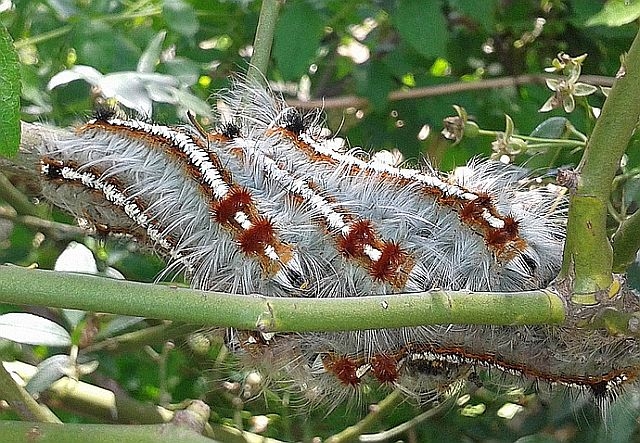 © Twigga
© Twigga
These hairy caterpillars are larvae of the Lappet Moth, they are highly gregarious.
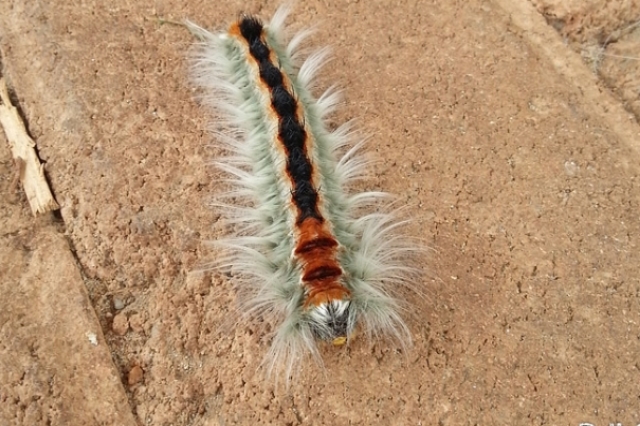 © PJL
© PJL
Port Elizabeth, Eastern Cape
Description
Male: Wingspan 54-58 mm, fore wing length 22-25 mm. Ground colour of the fore wing dark brown. Medial field is distinctly limited by black irregular to serrated lines. External field completely curved, pointed with black band on light brown ground colour. Hind wing brown with indistinct external pattern. Abdomen brown with distinct light brown dorsal spot. Lighter forms with contrasting dark yellow shading on fore wings.
Female: Wingspan 80 mm, fore wing length 35 mm. Ground colour of the fore wing brown, lighter than in males. Medial field dark brown,
with distinct black bordering, sometimes additionally bordered outside with grey shading. External field dark, dotted with dark brown
at the external fascia. Hind wing pale brown with lighter base and indistinct external pattern. Abdomen uniformly yellow.
Pure white lateral tufts of hairs are typical for the larva of this species (orange in related E. capensis); the dorsal scale pattern is variegated and the development of white scales is also variable.
Diagnosis: The species is easily distinguished from the related E. capensis, by contrasting darker wing colouration; medial fasciae on the fore wing hardly developed, sometimes just scarcely visible on the dark ground colour. Strong ferruginous to brown darkness of the wings is quite typical for both sexes; differs clearly from E. bifascia, by larger size and broader wings.
Biology
Acacia cyclops, A. saligna, A. karroo (Fabaceae), Chrysanthemoides monilifera (Asteraceae), Diospyros lycioides (Ebenaceae), Euclea racemosa (Ebenaceae), Pinus radiata (Pinaceae) and Rhus pyroides (Anacardiaceae) are known to be host plants.
At Johannesburg the larvae of the species were found on Hedera helix (Araliaceae) (J. Joannou, pers. comm.), and at Durbanville (Cape Prov.) on Acacia cyanophilla (coll. TMP).
Distribution
South Africa.
Links:
https://www.zobodat.at/pdf/Neue-Entomol ... 1-0075.pdf
Family Lasiocampidae. Subfamily Lasiocampinae
 © Twigga
© TwiggaThese hairy caterpillars are larvae of the Lappet Moth, they are highly gregarious.
 © PJL
© PJLPort Elizabeth, Eastern Cape
Description
Male: Wingspan 54-58 mm, fore wing length 22-25 mm. Ground colour of the fore wing dark brown. Medial field is distinctly limited by black irregular to serrated lines. External field completely curved, pointed with black band on light brown ground colour. Hind wing brown with indistinct external pattern. Abdomen brown with distinct light brown dorsal spot. Lighter forms with contrasting dark yellow shading on fore wings.
Female: Wingspan 80 mm, fore wing length 35 mm. Ground colour of the fore wing brown, lighter than in males. Medial field dark brown,
with distinct black bordering, sometimes additionally bordered outside with grey shading. External field dark, dotted with dark brown
at the external fascia. Hind wing pale brown with lighter base and indistinct external pattern. Abdomen uniformly yellow.
Pure white lateral tufts of hairs are typical for the larva of this species (orange in related E. capensis); the dorsal scale pattern is variegated and the development of white scales is also variable.
Diagnosis: The species is easily distinguished from the related E. capensis, by contrasting darker wing colouration; medial fasciae on the fore wing hardly developed, sometimes just scarcely visible on the dark ground colour. Strong ferruginous to brown darkness of the wings is quite typical for both sexes; differs clearly from E. bifascia, by larger size and broader wings.
Biology
Acacia cyclops, A. saligna, A. karroo (Fabaceae), Chrysanthemoides monilifera (Asteraceae), Diospyros lycioides (Ebenaceae), Euclea racemosa (Ebenaceae), Pinus radiata (Pinaceae) and Rhus pyroides (Anacardiaceae) are known to be host plants.
At Johannesburg the larvae of the species were found on Hedera helix (Araliaceae) (J. Joannou, pers. comm.), and at Durbanville (Cape Prov.) on Acacia cyanophilla (coll. TMP).
Distribution
South Africa.
Links:
https://www.zobodat.at/pdf/Neue-Entomol ... 1-0075.pdf
-
Klipspringer
- Global Moderator
- Posts: 5862
- Joined: Sat Sep 14, 2013 12:34 pm
- Country: Germany
- Contact:
Re: AW Insect Book: Moths (Lepidoptera) Geometridae Ennominae
Wave Moth Scopula nigrinotata
Family Geometridae. Subfamily Sterrhinae. Tribe Scopulini

Garden in Johannesburg © BluTuna
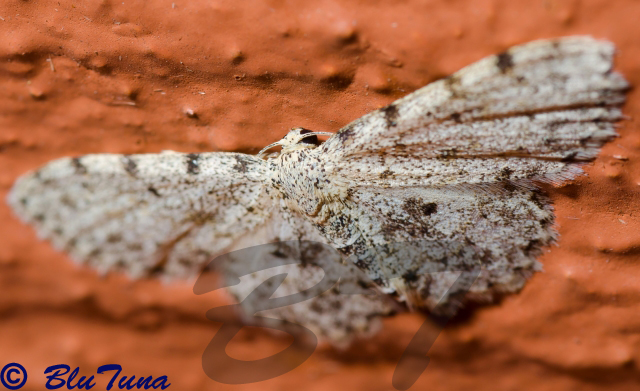
Garden in Johannesburg © BluTuna
Identification:
Wingspan about 26 mm. Three wavy transverse lines run from forewing to hindwing; and a series of dark spots on the wings.
Links:
https://www.africanmoths.com/pages/GEOM ... otata.html
https://academic.oup.com/zoolinnean/art ... 73/2726869
Family Geometridae. Subfamily Sterrhinae. Tribe Scopulini

Garden in Johannesburg © BluTuna

Garden in Johannesburg © BluTuna
Identification:
Wingspan about 26 mm. Three wavy transverse lines run from forewing to hindwing; and a series of dark spots on the wings.
Links:
https://www.africanmoths.com/pages/GEOM ... otata.html
https://academic.oup.com/zoolinnean/art ... 73/2726869
-
Klipspringer
- Global Moderator
- Posts: 5862
- Joined: Sat Sep 14, 2013 12:34 pm
- Country: Germany
- Contact:
Re: AW Insect Book: Moths (Lepidoptera) Geometridae Ennominae
Pale Waved Umber Menophra obtusata
Family Geometridae. Subfamily Ennominae. Tribe Boarmiini
 © BluTuna
© BluTuna
Garden in Johannesburg
Links:
https://www.africanmoths.com/pages/GEOM ... usata.html
Family Geometridae. Subfamily Ennominae. Tribe Boarmiini
 © BluTuna
© BluTunaGarden in Johannesburg
Links:
https://www.africanmoths.com/pages/GEOM ... usata.html
-
Klipspringer
- Global Moderator
- Posts: 5862
- Joined: Sat Sep 14, 2013 12:34 pm
- Country: Germany
- Contact:
Re: AW Insect Book: Moths (Lepidoptera) Geometridae Ennominae
Geometer Moth Zamarada metallicata
Family Geometridae. Subfamily Ennominae. Tribe Cassymini
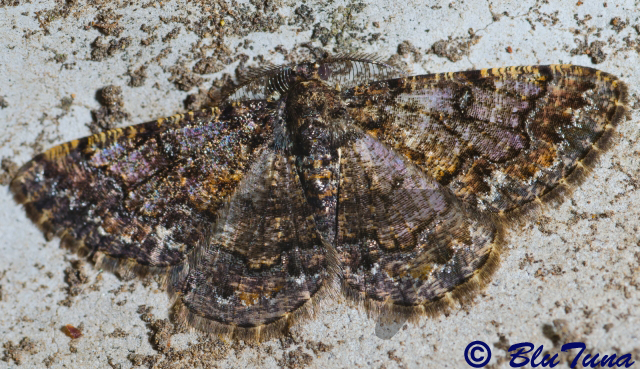 © BluTuna
© BluTuna
Garden in Johannesburg
Description by Warren (1914):
Distribution
Botswana, Namibia, South Africa, Zimbabwe.
Links:
https://www.africanmoths.com/pages/GEOM ... icata.html
https://www.biodiversitylibrary.org/pag ... 4/mode/1up
Family Geometridae. Subfamily Ennominae. Tribe Cassymini
 © BluTuna
© BluTunaGarden in Johannesburg
Description by Warren (1914):
Distribution
Botswana, Namibia, South Africa, Zimbabwe.
Links:
https://www.africanmoths.com/pages/GEOM ... icata.html
https://www.biodiversitylibrary.org/pag ... 4/mode/1up
-
Klipspringer
- Global Moderator
- Posts: 5862
- Joined: Sat Sep 14, 2013 12:34 pm
- Country: Germany
- Contact:
AW Insect Book: Moths (Lepidoptera)
Pearl Moth Pycnarmon cribrata
Superfamily Pyraloidea. Family Crambidae. Subfamily Spilomelinae
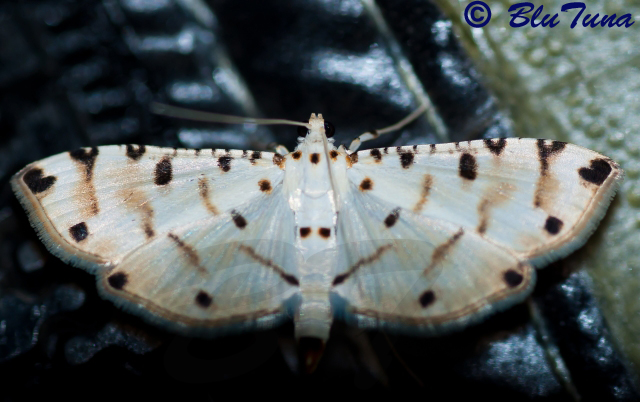 © BluTuna
© BluTuna
Shingwedzi camp, Kruger National Park (May 2014)
Description
Body and wings white with many black dots; wings also with some short brown streaks. The wingspan is about 30 mm.
Caterpillars are leaf-folders.
Distribution
DRCongo, Kenya, Madagascar, Malawi, Mozambique, Sierra Leone, South Africa, Zambia, Zimbabwe.
Links:
African Moths
Superfamily Pyraloidea. Family Crambidae. Subfamily Spilomelinae
 © BluTuna
© BluTunaShingwedzi camp, Kruger National Park (May 2014)
Description
Body and wings white with many black dots; wings also with some short brown streaks. The wingspan is about 30 mm.
Caterpillars are leaf-folders.
Distribution
DRCongo, Kenya, Madagascar, Malawi, Mozambique, Sierra Leone, South Africa, Zambia, Zimbabwe.
Links:
African Moths
-
Klipspringer
- Global Moderator
- Posts: 5862
- Joined: Sat Sep 14, 2013 12:34 pm
- Country: Germany
- Contact:
Re: Africa Wild Insect Book: Moths (Lepidoptera)
King Monkey Tantaliana tantalus
Superfamily Bombycoidea. Family Eupterotidae. Subfamily Janinae
Kruger National Park, Skukuza (April 2016) © Flutterby
Description
Wingspan 100 mm. Large moth with a hairy body. Forewings dark grey with a discal black spot. Hindwings fawn coloured with 4 curved brown bands, third and fourth band broad.
Distribution
Botswana, Gambia, South Africa, Zimbabwe.
Habitat
This species is commonly found in open woodlands and forests.
Biology
Larval foodplants: Cordia caffra, Jasminum streptopus.
Links:
African Moths
https://www.biodiversitylibrary.org/ite ... 2/mode/1up
Superfamily Bombycoidea. Family Eupterotidae. Subfamily Janinae
Kruger National Park, Skukuza (April 2016) © Flutterby
Description
Wingspan 100 mm. Large moth with a hairy body. Forewings dark grey with a discal black spot. Hindwings fawn coloured with 4 curved brown bands, third and fourth band broad.
Distribution
Botswana, Gambia, South Africa, Zimbabwe.
Habitat
This species is commonly found in open woodlands and forests.
Biology
Larval foodplants: Cordia caffra, Jasminum streptopus.
Links:
African Moths
https://www.biodiversitylibrary.org/ite ... 2/mode/1up
Re: Africa Wild Insect Book: Moths (Lepidoptera)
Owlet Moth Dysgonia properans (Walker, 1858)
Superfamily: Noctuoidea. Family: Erebidae. Subfamily: Erebinae.
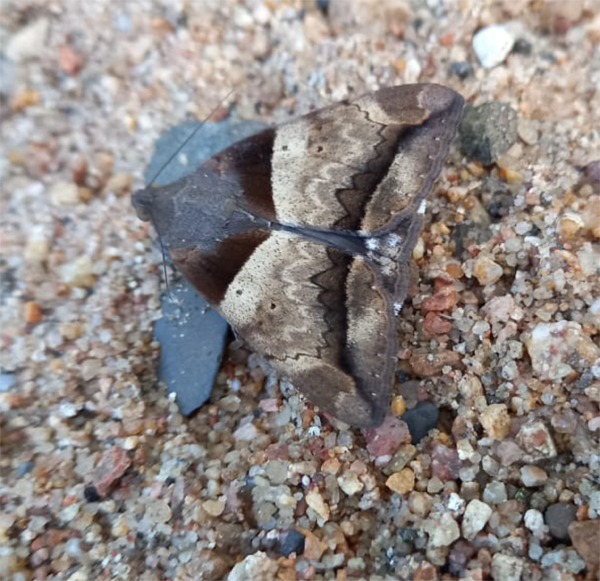
KNP Satara by mposthumus
Description
Adults of the Genus Dysgonia are described by Goater et al. (2003), with a combination of the following characters:
*antenna in male ciliate
*labial palpi thick and ascending
*thorax and abdomen smooth-scaled, without crests
*mid-tibia with rowels, in male covered with long hair-scales
*uncus stout with dorsal crest or superuncus, and two pointed tips
*tegumen and vinculum strongly built
*valvae bilobed
*costa rod-like
*clasper and ampulla very strongly developed
* sacculus with large subbasal coremata, and with a broad-based process
*aedeagus short with a small lateral spine by apex
*vesical with multiple small diverticula
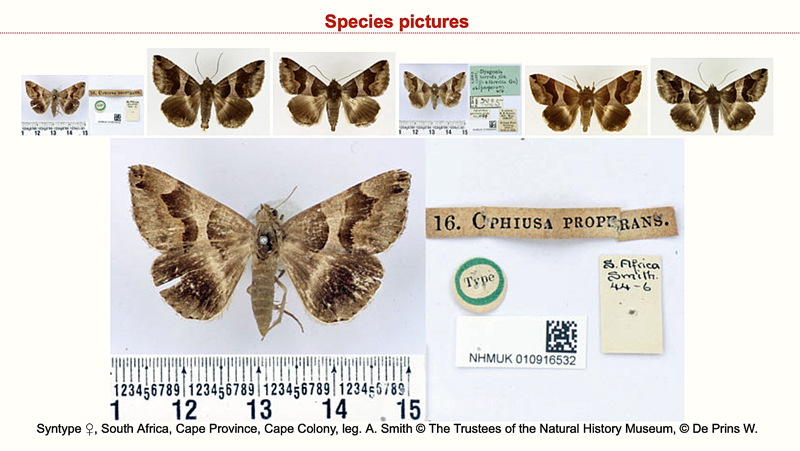
Type Locality
[South Africa, Cape Province], Cape Colony, leg. A. Smith; [KwaZulu-Natal], Port Natal [Durban], leg. Gueinzius.
Hostplant
Family: Euphorbiaceae ; Genus/species : Acalypha glabrata
https://www.afromoths.net/species/show/33863
Superfamily: Noctuoidea. Family: Erebidae. Subfamily: Erebinae.

KNP Satara by mposthumus
Description
Adults of the Genus Dysgonia are described by Goater et al. (2003), with a combination of the following characters:
*antenna in male ciliate
*labial palpi thick and ascending
*thorax and abdomen smooth-scaled, without crests
*mid-tibia with rowels, in male covered with long hair-scales
*uncus stout with dorsal crest or superuncus, and two pointed tips
*tegumen and vinculum strongly built
*valvae bilobed
*costa rod-like
*clasper and ampulla very strongly developed
* sacculus with large subbasal coremata, and with a broad-based process
*aedeagus short with a small lateral spine by apex
*vesical with multiple small diverticula

Type Locality
[South Africa, Cape Province], Cape Colony, leg. A. Smith; [KwaZulu-Natal], Port Natal [Durban], leg. Gueinzius.
Hostplant
Family: Euphorbiaceae ; Genus/species : Acalypha glabrata
https://www.afromoths.net/species/show/33863


